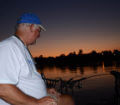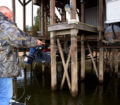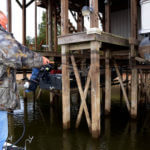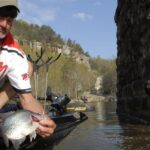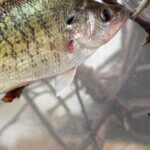John’s Note: Darrell Baker of Centre, Alabama, has been fishing and guiding on Weiss Lake in northeast Alabama for 40 years. He’s seen wintertime drawdowns and droughts and fished in freezing weather during the winter months. The State of Alabama has had one of the worst droughts that we’ve ever seen this past year in 2016. When we went fishing in the middle of November with the lake 6-feet below normal pool, I was surprised when Baker said, “The first thing we’re going to do is shoot docks.”
As Darrell Baker’s boat went down almost to the end of the boat ramp, all I could see, except for the small stream of water near the boat ramp, were docks out of the water. Shooting docks is a technique that crappie fishermen use to force their jigs to travel from 10 yards to often 30 yards away underneath a dock. To give the jig energy to travel that far but low to the water, a right-handed angler will hold his rod in his right hand, and let out about 2-3 feet of line with a jig attached to the end of the line. Then he’ll hold the jig between his thumb and his index finger on his left hand, and pull the rod tip down as he pulls the jig back. When the rod is almost at its breaking point, he releases the jig at almost the same time he straightens his index finger on his right hand, which is holding the line. This action causes the jig to fly from the angler’s fingertips far back under the dock where crappie are often hiding. Using a slow, steady retrieve, he can catch the crappie under the dock where many other anglers don’t fish.
 During this mid-November crappie-fishing trip in the extreme drought, I asked Baker, “Are there any docks here on Weiss not out of the water?” He answered, “John, I’ve got one dock that sits right on the edge of a deep-water drop-off with about 2-3 feet of water under this dock. The crappie will come out of the deep water, move under the dock, wait for bait fish to come by and then feed on them. The real secret to shooting docks, when you have a winter drawdown or a drought, is to find the docks sitting right on the edge of deep water. Some of the docks that I shoot, at this time of the year, will have 3-8 feet of water in front of the dock and partially back under the dock. The water temperature is in the mid-60s here in mid-November. So, the crappie know they have to feed-up for the cold weather that is fast approaching. If you can locate docks like this, you’ll often find good numbers of crappie holding under them.
During this mid-November crappie-fishing trip in the extreme drought, I asked Baker, “Are there any docks here on Weiss not out of the water?” He answered, “John, I’ve got one dock that sits right on the edge of a deep-water drop-off with about 2-3 feet of water under this dock. The crappie will come out of the deep water, move under the dock, wait for bait fish to come by and then feed on them. The real secret to shooting docks, when you have a winter drawdown or a drought, is to find the docks sitting right on the edge of deep water. Some of the docks that I shoot, at this time of the year, will have 3-8 feet of water in front of the dock and partially back under the dock. The water temperature is in the mid-60s here in mid-November. So, the crappie know they have to feed-up for the cold weather that is fast approaching. If you can locate docks like this, you’ll often find good numbers of crappie holding under them.
“W hen I’m shooting docks, I’ll often use the 1-1/2-inch Lit’l Fishie made by Creme Lure Company (http://www.cremelure.com), or the Southern Pro Stinger Shad http://www.southernpro.com. The Lit’l Fishie is a swimbait, and the tail moves back and forth as you reel it. This bait is especially productive when the crappie are actively feeding, and I can get a reaction strike using this lure. If the crappie aren’t feeding actively, and I need a more-subtle presentation, I’ll use the Stinger Shad and reel it close to the bottom. I fish the Stinger Shad like most people will fish a plastic worm for bass. I’ll make a very-slow presentation, and I’ll hop the lure up and let it fall back to the bottom. As the bait starts to fall, this is when the strike most often will come. At this time of the year in late fall, the strike usually will be very light. You may not even feel the bite at all. You may just see your line moving to the left or the right or shaking just a little. That’s when you have to set the hook.”
hen I’m shooting docks, I’ll often use the 1-1/2-inch Lit’l Fishie made by Creme Lure Company (http://www.cremelure.com), or the Southern Pro Stinger Shad http://www.southernpro.com. The Lit’l Fishie is a swimbait, and the tail moves back and forth as you reel it. This bait is especially productive when the crappie are actively feeding, and I can get a reaction strike using this lure. If the crappie aren’t feeding actively, and I need a more-subtle presentation, I’ll use the Stinger Shad and reel it close to the bottom. I fish the Stinger Shad like most people will fish a plastic worm for bass. I’ll make a very-slow presentation, and I’ll hop the lure up and let it fall back to the bottom. As the bait starts to fall, this is when the strike most often will come. At this time of the year in late fall, the strike usually will be very light. You may not even feel the bite at all. You may just see your line moving to the left or the right or shaking just a little. That’s when you have to set the hook.”
Baker uses 6-pound-test Gamma Hi-Vis line (http://gammafishing.com/) but will use 4-pound line from time-to-time. He likes the Hi-Vis line, because many times if you don’t see the line twitch or move, you won’t know when you’re getting a bite. Oftentimes, the crappie will take the bait swimming up toward the surface, causing the line to pile up on the surface. Or, the crappie will swim off with the bait, never making the tip of the rod move at all. According to Baker, “In the winter months, the crappie bite is often very, very light. The instant that line moves, I set the hook and set it hard. If I don’t, oftentimes, the crappie will swallow the bait, and retrieving your jig is much more difficult. Many times during the winter months, we’ll be fishing on cloudy overcast days. This makes seeing most lines that aren’t Hi-Vis very difficult.” If you’re fishing a really-clear lake, you may not want to use a highly-visible line, because the crappie may be able to see the line. On Alabama’s Coosa chain of rivers where Baker and I were fishing in mid-November, the water always tends to be a little dingy. By using Hi-Vis line, you can detect the strike much easier.
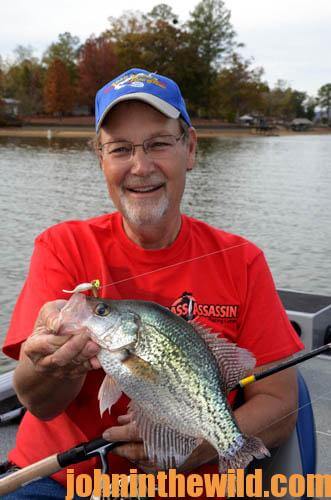 Baker uses the 5-1/2-foot ultralight B‘n’M Sharp Shooter rod (https://www.bnmpoles.com/p-43-sharpshooter.aspx) when he’s shooting docks. “The Sharp Shooter was designed by B‘n’M strictly for shooting docks,” Baker says. “The rod is very limber and allows you to really bend it as the Sharp Shooter stores energy to enable you to shoot a very-light jig long distances. It also has enough backbone, so you can lift that 1-1/2-pound or 2-pound crappie in the boat once you catch it. The tip is very sensitive to help you see or feel a very-light bite. This rod is ideal for me, because the rod bends back so far that it allows me to shoot my jig all the way to the backs of most docks I fish. Then when I catch a crappie, I usually can use the rod to lift it into the boat. I use the B‘n’M spinning reels, because they are small, but they have a big enough spool to let the line easily flow off the reel after I take the shot. One other tool I use quite a bit is Reel Magic (https://www.ttiblakemore.com), a lubricant that you can spray on your line, and it relaxes the line, so you have very little line slap as the line goes through the guides on the rod. When you shoot a jig, the jig will go farther if you have less line slap.”
Baker uses the 5-1/2-foot ultralight B‘n’M Sharp Shooter rod (https://www.bnmpoles.com/p-43-sharpshooter.aspx) when he’s shooting docks. “The Sharp Shooter was designed by B‘n’M strictly for shooting docks,” Baker says. “The rod is very limber and allows you to really bend it as the Sharp Shooter stores energy to enable you to shoot a very-light jig long distances. It also has enough backbone, so you can lift that 1-1/2-pound or 2-pound crappie in the boat once you catch it. The tip is very sensitive to help you see or feel a very-light bite. This rod is ideal for me, because the rod bends back so far that it allows me to shoot my jig all the way to the backs of most docks I fish. Then when I catch a crappie, I usually can use the rod to lift it into the boat. I use the B‘n’M spinning reels, because they are small, but they have a big enough spool to let the line easily flow off the reel after I take the shot. One other tool I use quite a bit is Reel Magic (https://www.ttiblakemore.com), a lubricant that you can spray on your line, and it relaxes the line, so you have very little line slap as the line goes through the guides on the rod. When you shoot a jig, the jig will go farther if you have less line slap.”
To contact Baker, you can go to his website at www.weisslakecrappieguides.com, call his cell phone at 256-557-0129, or email him at [email protected].
To learn much more about crappie fishing, get John E. Phillips’ Kindle eBooks and some print books, “Crappie: How to Catch Them Fall & Winter,” “Crappie: How to Catch Them Spring and Summer,” “Catch Cold Water Crappie Now” and “Catch Crappie All Year: Fishing a Single Pole, Using No Boat and Farming Crappie” by clicking on each, or go to www.barnesandnoble.com or to https://johninthewild.com/books/#crappie
To receive and download for free “The Crappie Catchers’ Cookbook,” by John and Denise Phillips, go to https://johninthewild.com/free-books.

